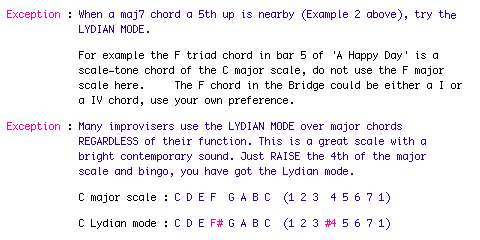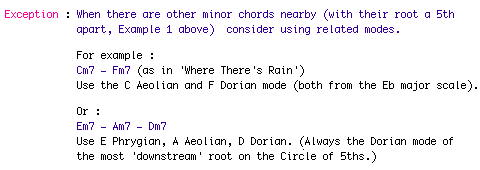(Down - Up - Top)
Im 12.2 - Chord Functions
It is important to understand the modes and the mode / chord relationships.
But usually the function of a chord is quite clear cut.
In most cases it can be regarded as part of :
a major key : IIm7 - V7 - IΔ
or (less common)
a minor key : IIø - V7 - Im7
Take this approach even when the chord is quite isolated.
In some cases the chord progression represents the whole or a part (other than II-V-I) of the scale-tone chord progression of the major scale.
IVΔ - VIIø - IIIm7 - VIm7 - IIm7 - V7 - IΔ (- IVΔ)
Example 1.
When there are 2 or 3 minor chords in Circle of 5ths order they represent a segment of above progression :
(IIIm7) - VIm7 - IIm7
In such case play the III Phrygian mode over IIIm7, the VI Aeolian mode over VIm7 and the II Dorian mode over IIm7. This sounds perhaps more difficult than it is, for all three modes use the same notes. Think therefore of using the II Dorian mode over all three chords.
Example 2.
Likewise when 2 major chords occur together they often represent :
IΔ - IVΔ
Here use the I major scale over Imaj7 and the IV Lydian mode over IVmaj7.
(Which again boils down to using the Imaj7 scale over both chords.)
Here follow some general guidelines :
- The major 7th chord is usually a Imaj7 chord : use the major scale.

- The dominant 7th chord is always a V7 chord : use the Mixolydian mode.

- The minor 7th chord is usually a IIm7 chord : use the Dorian mode.
(If it is a Im7 chord of a IIø - V7 - Im7 : still use the Dorian mode.)

- The half diminished chord is a VIIø chord when it is followed by a minor chord : use the Locrian mode
(The Locrian mode is derived from the major scale 1 semitone above.
For example the F# Locrian mode is the G major scale startion on F#)
The half diminished chord is a IIø chord when it is followed by a dominant chord : use the Harmonic minor scale one tone lower.

- The diminished 7th chord is in most cases a passing chord. Use chord tones.
(Or the 8-note diminished scale)
GENERAL COMMENT
The general guide rules above are only abandonned when there are larger scale-tone chord segments involved. These can be spotted very easily.
Take for example Hey There or Street Dance. Playing Dorian modes here over all minor chords and the major scale over the F chord sounds most odd and inappropriate.
Also in these scale-tone chord songs you do not need to think about all the modes involved. Simply focus on the parent major scale and the chord tones as they go by, and the modes will look after themselves.
IN RECAP
- Audio 12.3 :
Major 7th chords -----> Major scale (or Lydian mode)
- Audio 12.4 :
Dominant 7th chords -----> Mixolydian modes (or harmonic minor a 5th down)
- Audio 12.5 :
Minor 7th chords -----> Dorian modes (unless associated with other minor chords)
- Audio 12.6 :
Half diminished chords -----> Locrian mode (or Harmonic minor a tone down)
(Down - Up - Top)
Im 12.5 - Improvisation - Overview
We have dealt in this Course with the two essential aspects of improvisation :
tone selection and phrasing.
Continue to work on the following elements.
A. Tone Selection
- Use of chord tones : L1.5
- Use of scale tones or tones of the appropriate mode : L2.4
- Use of critical tones, distinguishing one scale from the next one : L5.6 - L6.4
- Focus on essential chord tones, the 3rd and 7th of the chord,
(and also the 9th), and their use as starting and ending notes of a
phrase : L8.4
- Use of guide tone lines ( consisting of chord tones and important melody
tones) to provide meaningful direction in a solo, especially over
monotonousor difficult chord passages : L9.5
B. Phrasing
- Alternate high activity (short notes) with low activity (long notes and
rests) : L1.4c
-
Use of accents on downbeats 2 and 4 and all offbeats positions : L6.4a
- Use of triplet quavers : L3.3a
- Selecting different starting and ending points for phrases : L7.5 - L8.4
- Use of dynamics (crescendo, decrescendo) and articulation (staccatos,
tenudos, slurred passages). Articulation of the last note of a phrase : L6.4a
- Variation of phrase length. Phrase across 'natural' phrase ending points
every 4 bars, and across the end of a chorus : L11.5
Keep working on these aspects and your improvisation will improve immensely.
Use as main vehicles for your improvisation practice :
- The 12 bar Blues in G, C, F and Bb (concert key)
- IIm7 - V7 - IΔ in all major keys
- IIø - V7(b9) - Im7 in all minor keys.
It is impossible to absorb everything at once. Do work on all 12 keys, but focus in the beginning most of your efforts on the easier keys : A - D - G - C - F - Bb. Then gradually extend your range.
(Down - Up - Top)
Im 12.6 - The Woodshed - Overview
We have focussed in this Course on :
- Seventh chords : L3.4 - L4.5
- Major scale : L1.9 - L2.6
- Mixolydian mode : L5.7 - L6.5
- Dorian mode : L7.6 - L8.6
- Harmonic minor scale : L9.6
- IIm7 - V7 - IΔ : L10.6
- IIø - V7 - Im7 : L11.6
To the above selection you can add the :
- Major pentatonic scale
- Minor pentatonic scale
- Blues scale
Digital Patterns
Once you are comfortable in playing a scale over a 2 octave range, practise them using digital patterns.
For example :
 You can use the Major scale Play-along track with 8 bars in each key, or use the special Play-along Library for Digital patterns.
You can use the Major scale Play-along track with 8 bars in each key, or use the special Play-along Library for Digital patterns.
Here is the 1231 - 2342 pattern in music notation :
Audio 12.9

You can also go up and down over 2 octaves playing the pattern in semiquavers (1/16 notes).
Here is the 1324 - 3546 pattern
Audio 12.10

Six Digital patterns you should learn
(Down - Up - Top)
Im 12.7 - Quiz
-
Unscramble these II-V-Is and place the chords in a logical order.
- G7 BbΔ Cm7 CΔ F7 Dm7
- Ab7 DΔ Ebm7 A7 DbΔ Em7
- Fm7 AΔ Gø B7 C7 E7
- CΔ Dm7 Bb7 Fø Ebm7 G7
- B7 Am7 CΔ F#ø GΔ D7 Em
- Write down the Dorian modes for these chords.
- Dm7
- Am7
- Bbm7
- Fm7
- F#m7
- Write the Mixolydian modes for these chords.
- F7
- F#7
- A7
- Bb7
- E7
- Write out the Locrian modes for these chords.
- Cø
- Fø
- Aø
- Gø
- F#ø
- What scale do you use for improvisation over each of the chords in these
progressions.
- Gm7 - C7 - FΔ
- Dm7 - C7 - Fm7
- Aø - D7 - Gm7
- Cm7 - Fm7 - Bb7
- E7 - AΔ - DΔ
- Am7 - D7 - G7
- Eø - A7 - DΔ
- B7 - E7 - A7
- Write out the II-V-Is in the following keys.
- F major
- Db major
- G minor
- A major
- D minor
Quiz ANSWERS
(Down - Up - Top)
Im 12.8 Practice Materials
( Up - Top - Impro Library)
Copyright © 1997 - 2007 Michael Furstner.